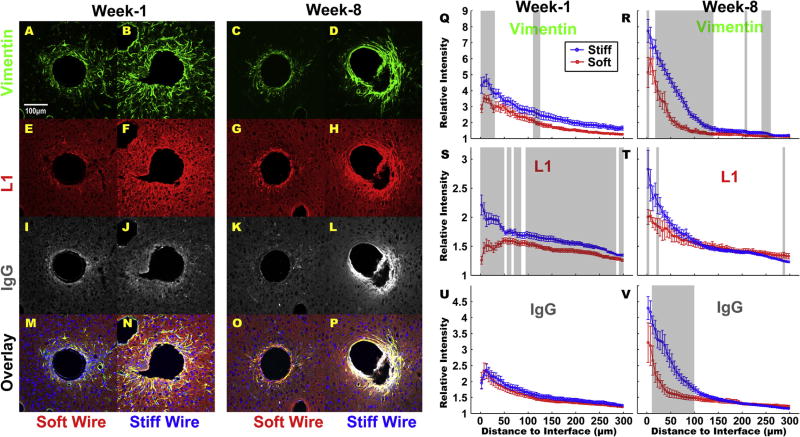Fig. 5.
Chronic BBB leakage and potential neural regeneration around implants. Vimentin (green) clearly aggregates around both implant types although the stiff wires cause a broad range increase of vimentin expression far from the implant as well. L1 (red) is associated with tissue response as well as possible developing oligodendrocytes for axon repair. Very strong L1 activity is observed around stiff implants at both time points. IgG (gray) indicates BBB leakage. IgG intensity around the stiff implants was very similar to that around soft wires at week 1 but became much stronger at week 8, indicating a significant chronic leakage of the BBB caused by the stiff implant. Scale bar = 100 µm. Q and R are normalized intensity values for Vimentin at week-1(soft N = 9, stiff N = 8) and week-8(soft N = 8, stiff N = 10), respectively; S and T are normalized intensity values for L1(week-1 soft N = 10, stiff N = 8, week-8 soft N = 9, stiff N = 10); U and V are normalized intensity values for IgG(week-1 soft N = 10, stiff N = 9, week-8 soft N = 10, stiff N = 11). Intensities are calculated 0 µm from the electrode-tissue interface until 300 µm away, with 5 µm bin size. Q and S demonstrate a broad range increase of Vimentin and L1 around stiff implants at week-1. R, T and V all indicate that a significant portion of the chronic tissue response was caused by the mechanical properties of the stiff implant. (For interpretation of the references to colour in this figure legend, the reader is referred to the web version of this article.)

